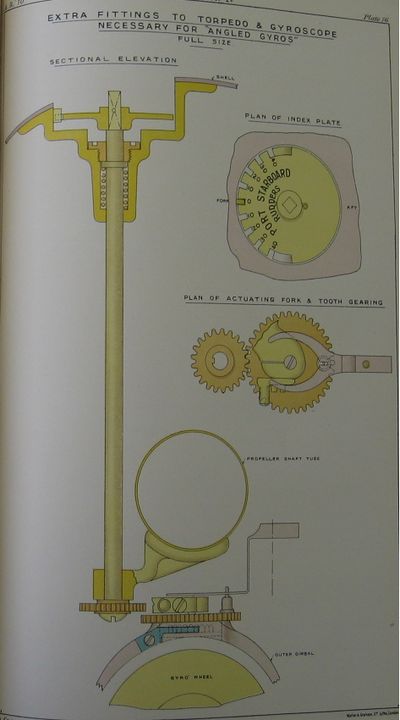Gyro Angle

A Gyro Angle (or Torpedo Gyro Angle) is an angular turn of a given number of degrees that a torpedo equipped with a gyroscope and some additional hardware could be set to assume as soon as it gained control in the water.
Trials
Britain first started experimenting with torpedoes capable of gyro angles aboard Furious in 1910 using two Mark VI* (cold) torpedoes. The initial tests allowed the gyros to work vertical rudders 0.36 rather than the customary 0.12 inch travel until the torpedo assumed its gyro angle, in order to speed its response. This resulted in a radius of turn measured at 50 yards after 7 yards of initial straight travel. [2]
| Fired to Starboard, own speed 12 knots, range 1,000 yards | |
|---|---|
| Gyro Angle | Remarks |
| Straight | 5 yards left |
| Straight | short but true |
| 10 right | Quick-turn device stuck, torpedo hit bottom |
| 10 left | 15 yards left |
| 20 left | 1 yard right |
| 20 right | stirred mud, 5 yards right |
| 20 right | hit |
| 30 right | <= 2 yards right |
| 40 right | short but true |
| 30 left | 1 yard left at 800 yards |
| 40 left | 12 yards left, but wind caught target |
The quick-turn apparatus was removed as unnecessarily complex, and the turn radius went to 200 yards as trials continued:[3]
| Fired to Starboard, own speed 12 knots, range 1,000 yards | |
|---|---|
| Angle | Remarks |
| 10 left | 1-2 yards right |
| 10 right | hit |
| 20 left | 3 yards left |
| 20 right | 7 yards right |
| 30 left | 3-4 yards left |
| 30 right | short, ~10 yards right |
Testing continued with a Mark VI*** H. H.B. heater torpedo from Furious steaming 15 knots. Six shots were made, and only one shot showed diving. Vernon recommended that the initial models should be able to take up angles as large as 40 degrees on either side, in 10 degree increments, without the quick-turn gear and that trials with all eight dreadnoughts of the First Battle Squadron should follow and henceforth all submerged tubes should receive gyro angling torpedoes.[4] [5]
By 1911, they were under trial in the Home Fleet.[6]
In March 1913, a XXX was issued regarding "Instructions for First Fittings of Angled Gyroscopes".[7]
Maturation
By 1916 (likely earlier), there were "gyro angle plugs" on British 21-in tubes, and it was approved to extend the practice to 18-in submerged broadside tubes. I presume that these permitted the gyro angle on the torpedo to be altered without removing it from the tube. They did not yet, however, had a design for effecting this with flooded submerged tubes, though a captured German submarine tube was noted as having this feature, albeit only for setting the gyro in 15 degree steps which was found to be somehow a simpler case. I do not know if these "plugs" are needed on A.W. tubes, as the source only indicates issues of submerged tubes. The plugs were unnecessary in Weymouth to Centaur class at over 18 knots, or on larger ships over 22 knots, as the tubes had no real pressure at those speed with the bar extended.[8]
By 1916, the granularity of angles that could be set was reduced to 5 degree increments, but the limits remained as 40 degrees.[9]
The use of gyro angling had impacts on torpedo control data instruments as well as on torpedo directors and sights. In typical fashion, there was considerable over-thinking as regards tangent bars.
When extended to 21-inch torpedoes, it was found that the gyro turns had a radius of approximately 800 feet rather than 600 feet as in the 18-inch torpedoes.[10]
Other Services
Apparently, the Americans were leading in these initiatives. [11]
See Also
Footnotes
- ↑ The Annual Report of the Torpedo School, 1910, Plate 16.
- ↑ Annual Report of the Torpedo School, 1910, pp. 45-47.
- ↑ Annual Report of the Torpedo School, 1910, p. 47.
- ↑ Annual Report of the Torpedo School, 1911, p. 90. (D.N.O. 26th July 1911)
- ↑ Annual Report of the Torpedo School, 1910, p. 48.
- ↑ Annual Report of the Torpedo School, 1911, p. iv
- ↑ Torpedo Orders serial no. 16, p. 22., referenced in Annual Report of the Torpedo School, 1913, p. ix.
- ↑ Annual Report of the Torpedo School, 1916, p. 74.
- ↑ Handbook of Torpedo Control, 1916, pp. 17-18.
- ↑ Annual Report of the Torpedo School, 1912, p. xii.
- ↑ Annual Report of the Torpedo School, 1911, p. viii, Section IX
Bibliography